A Cheese Expert's Guide to 10 Essential Cheeses to Know and Love
If you're looking to dive deeper into cheese, consider these 10 a good starting point.
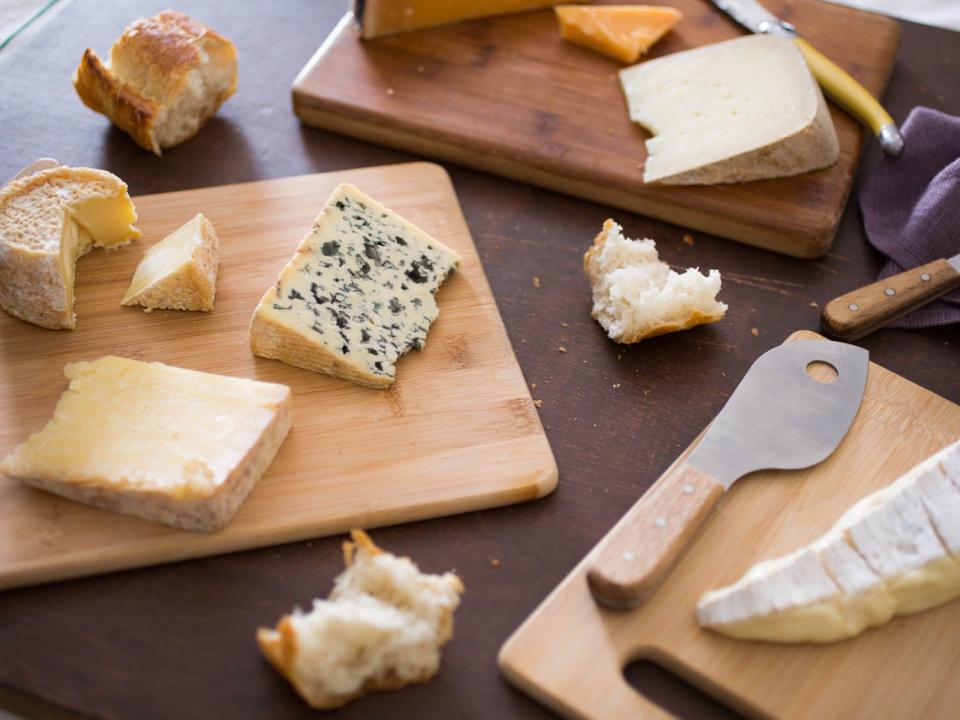
Serious Eats / Vicky Wasik
One of the questions I'm most frequently asked as a cheese person is, "What cheese do you have at home?" The honest answer is that it's rarely the newest, weirdest offering from some creamery no one's heard of. Most of the time I stick to my greatest hits list.
The following 10 cheeses are what I'm most likely to recommend when cheese explorers ask for an upgrade on their old reliables. If you're looking to dive deeper into cheese, consider them a good starting point.
Burrata
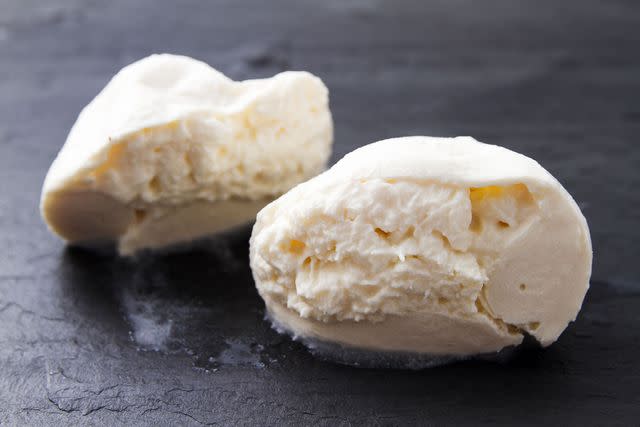
Serious Eats / Robyn Lee
Where it's from: Italy, US.
Milk: Cow.
Pasteurized
Aroma: A glass of cold, fresh milk.
Flavor: Lush milk, grassy, briny.
Texture: Tender, creamy, never chewy.
Character: The cheese to bathe in.
Recommended brands: Bel Gioioso, DiBruno Bros., DiStefano, Lioni Latticini, Maplebrook.
I've never been to the Italian region of Puglia. Honestly, I've been told it's sort of a food wasteland as far as Italy goes, with one powerfully seductive exception: burrata. This bulging, bursting bomb of lactic decadence is like mozzarella's souped-up and much sexier cousin. It's essentially a hollowed-out ball of mozzarella filled with scraps and shreds of mozzarella which are sometimes soaked in cream. It's the most perishable cheese you can import; in Italy it's eaten on the morning of its production. You can push its life to two weeks, enough time to get it here on a plane and sell it in a few days before it sours, but this is challenging under the best circumstances.
That's why I look to several American producers who are making respectable and sometimes deliriously good approximations. The best burrata are so tender and moist, with such thin exterior skins, that handling the baseball-sized rounds is risky as they're likely to burst milky rivers down your arm. This cheese is all about impeccable freshness: sweet, clean milk and a slight briny finish. Nothing more, nothing less, nothing to hide behind.
Greek Feta
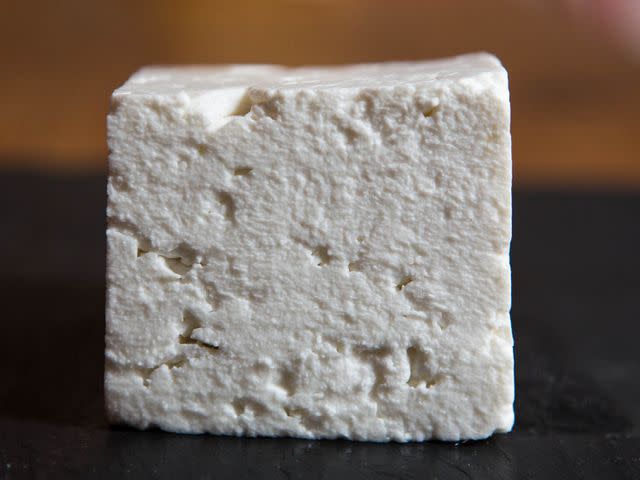
Serious Eats / Vicky Wasik
Where it's from: Greece.
Milk: Sheep, goat.
Pasteurized
Aroma: Clean, deep sea.
Flavor: Tangy, lemony, milky-rich.
Texture: Moist and crumbly, but creamy under tooth.
Character: Emminently snackable.
Recommended brand: Mt. Vikos.
In most instances, I am a big advocate for American-made cheeses. Feta is one area where I'm not. While Greek Feta is a PDO (protected designation of origin) cheese, made of a blend of sheep and goat milk, the name "feta" has been co-opted by producers in the U.S. for brined white cheese, typically pre-crumbled in cups. Most of the time, this cheese is 100% cows' milk and bears no resemblance to the savory, sea-salty chunks of fatty, tangy feta commonly eaten throughout the day in Greece.
The difference is remarkable; the original is so far superior to cheap imitators that no comparison is warranted. You can find 100% goat milk versions, but the fat and heft of sheep milk is part of the delicate balance that makes this cheese great.
Brie de Meaux-Style Brie
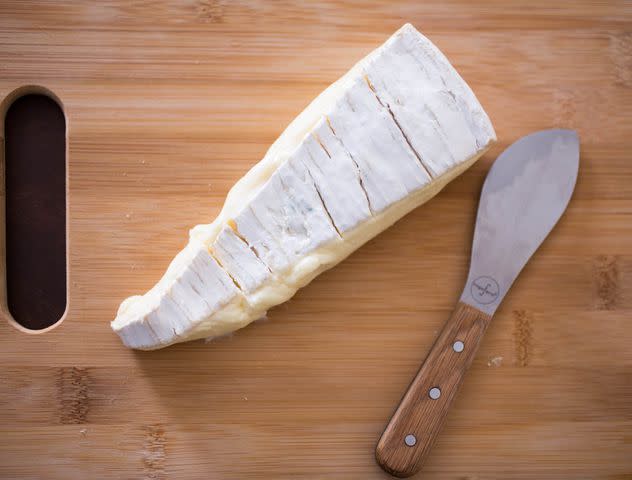
Serious Eats / Vicky Wasik
Where it's from: France.
Milk: Cow.
Pasteurized
Aroma: Cooked broccoli and cauliflower.
Flavor: Unfolding layers of vegetal and truffle.
Texture: Sticky, slightly stretchy, slippery.
Character: Ecstatic.
Recommended brands: Ferme de Jouvence Brie Fermier Jouvence, Rouzaire's Brie de Nangis or Fromage de Meaux (both are pasteurized but available in the US).
Brie de Meaux AOC and Camembert de Normandie AOC are both regionally protected cheeses, hard to find and illegal to bring to the States. Maybe that's why cheese geeks covet them and their worthy imitators. These cheeses also happen to set an extreme flavor benchmark far more intense than most Brie on the market: one that smells like very slowly, lovingly, overcooked broccoli simmered in well-salted water. It tastes savory, like the final spoonful of broccoli-cheese soup, but one made out of fat and sweet cream. The cheese is garlicky with rich, condensed flavor; breathe out after taking a bite for a whiff of pleasantly moldy damp hay.
Tip
Actual Brie de Meaux AOC is, by French law, a raw milk cheese aged fewer than 60 days and is therefore not available in the US. Shops claiming to sell Brie de Meaux are not actually doing so.
Pyrénées Sheep
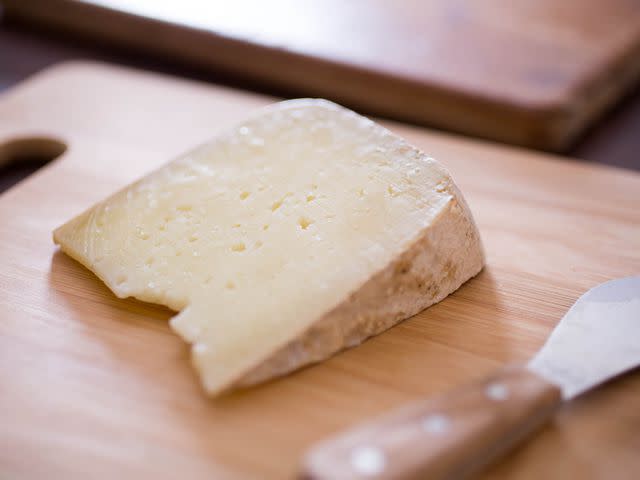
Serious Eats / Vicky Wasik
Where it's from: France.
Milk: Sheep.
(Un)Pasteurized
Aroma: Hay, nut skin.
Flavor: Platonically cheesy.
Texture: Dense, moist chew.
Character: Delicate.
Recommended brands: Ossau Iraty PDO.
Sheep cheese is hardly the everyday cheese for most Americans; as far as common references go, Spanish Manchego and Italian pecorino are it.
Lesser known, but easily more sexy and approachable, are the aged sheep cheeses of the French Pyrénées. Firm, smooth, and supple, these cheeses strike a balance between fatty chew, impressions of grass and hay (without actually tasting like grass and hay), and a sweet nuttiness like New York City's nut vendors in winter. Some might call them boring. I'd argue that they're subtle and quite complex, but quietly so.
Comté
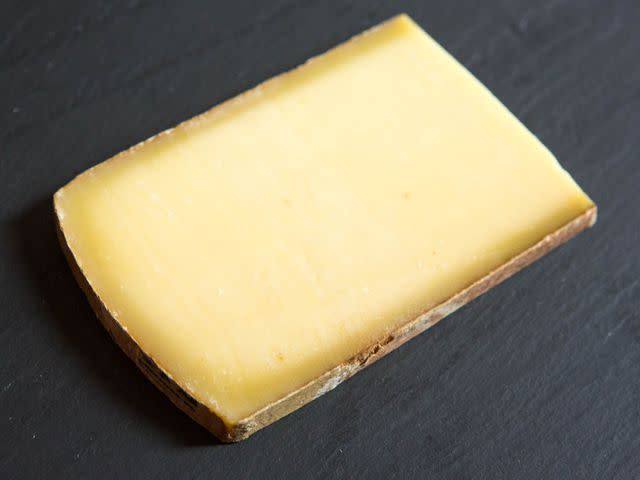
Serious Eats / Vicky Wasik
Where it's from: France.
Milk: Cow.
Raw
Aroma: Warm croissants.
Flavor: An extraordinary range, from sweet and gentle to coffee and cacao.
Texture: So moist, firm yet barely knitted together.
Character: Mercurial and fascinating.
Recommended brands: Fort St. Antoine (aging facility), Marcel Petite (the affineur at Fort St. Antoine, so essentially the same thing). Perhaps the best Comté is Essex Street Comté, an American importer working with Fort St. Antoine.
Comté's production cycle and history have much in common with Gruyère. Produced in the Jura Massif region of Eastern France, Comté is both an AOC and AOP regulated cheese resulting from a careful partnership between 3,000 family farms, roughly 170 fruitieres (village dairies), and a few select affineurs. The breeds of cow whose exclusively raw milk may be used to make it are limited to Montbéliarde and French Simmental. They're fed a strict grass diet and silage feed is not allowed.
Unlike Gruyère, Comté milk is partially skimmed before heating in copper vats. The cheeses are similarly graded (top scorers get a green band, lower scorers a brown band, lowest don't receive the Comté name), but Comté wheels may age for as long as 18 months, and sometimes more. This age range is one of the challenges Comté face in the US market—it is, essentially, five cheeses in one category.
Younger wheels are mild to the point of timidity (worse if you're talking brown label young wheels), with pleasant but forgettable notes of butter and caramel. In France their intended use is for cooking, but in the States the price point on Comté turns even young cheeses into "special occasion" items put on cheese plates.
A better way to describe good, older Comté, as one cheesemonger friend of mine puts it, is "Saturday afternoon cheese." You could eat it all damn day. It's subtle, complex, and unbelievably moist. The flavor is smoother and less salty than Gruyère, and I find more stone fruit than Gruyère's beefiness. That said, Comté's subtlety is lost on folks raised on big, sharp, and butt-kicking flavor, and if you want a hugely assertive cheese, this isn't it. But that's what makes it so ephemerally delicious.
Tip
Comté dies quickly in plastic wrap, so when you buy it, have your cheesemonger cut it off the wheel in front of you.
Clothbound Cheddar
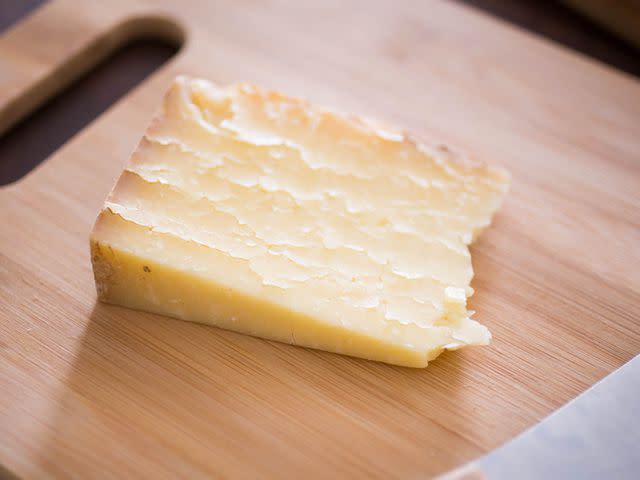
Serious Eats / Vicky Wasik
Where it's from: US, England.
Milk: Cow.
(Un)Pasteurized
Aroma: From brown butter to grass to damp caves.
Flavor: Buttered toast to bitter greens.
Texture: Flaky nubbins.
Character: Not your Mama's Sharp Cheddar.
Recommended brands: American: Beecher's Flagship Reserve, Cabot Clothbound, Flory's Truckle. British: Montgomery's, Isle of Mull, Quicke's.
Compared to block Cheddar, clothbound Cheddar is less about sharpness and more about complexity: earthy, caramel, brothy, or fruity flavors prevail. It's made in a wheel shape, typically 20 to 60 pounds, wrapped in muslin or similar fabric and sealed with a semi-permiable fat layer, usually lard. As a result, clothbound Cheddar loses more moisture as it ages than block Cheddar, resulting in a drier, flakier texture than block Cheddar. Accordingly, it costs more money. Labor factors into that cost, too: Aging clothbound Cheddar (typically nine to 18 months) requires extensive flipping, brushing, and hands-on maintenance.
American clothbound Cheddars tend toward a brown butter flavor, often with a lingering toffee or caramel finish. British clothbound Cheddars, on the other hand, are often far earthier, with celery root and soil impressions.
Aged (Goat) Gouda
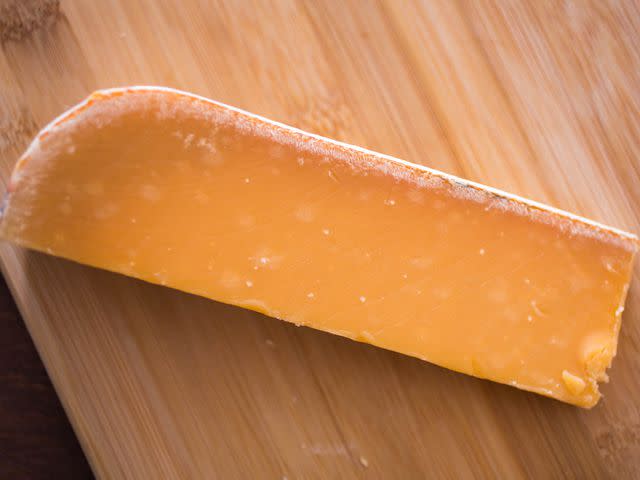
Serious Eats / Vicky Wasik
Where it's from: The Netherlands.
Milk: Goat.
Pasteurized
Aroma: Juicy fruit gum, butter pecan ice cream.
Flavor: Nearly burnt caramel.
Texture: Firm yet velvety.
Character: Pineapple upside down cake.
Recommended brand: Brabander.
Aged Goudas in general are a revelation for their crunchy, crystalline texture, like some delectable crayon. That plus butterscotch and bourbon flavors makes them practical no-brainers as crowd-pleasing cheeses. Aged goat Gouda offers an extra twist, and it's the perfect retort for those who decry goat cheeses.
Goat cheeses made for aging sweeten and mellow with time. Add in Gouda's own personality and you get a smooth, bone-white paste that feels velvety on the tongue. It's luxurious dulce de leche in cheese form.
Bleu d'Auvergne AOC/PDO
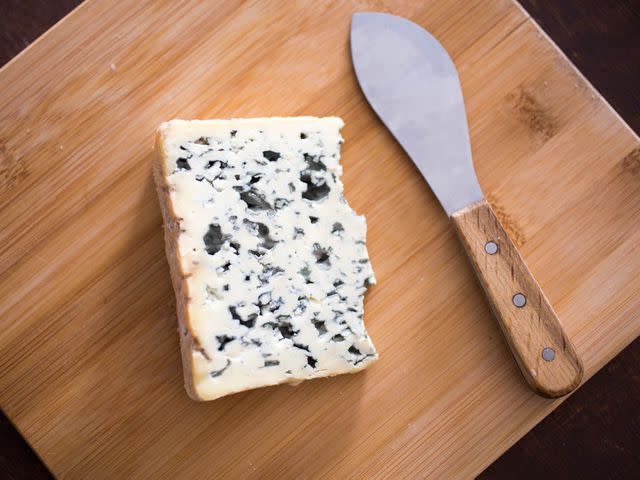
Serious Eats / Vicky Wasik
Where it's from: France.
Milk: Cow.
(Un)Pasteurized
Aroma: Quite a lot: horsey, leathery.
Flavor: Salt and sweet in perfect balance.
Texture: Belly fat, like that last five pounds you're trying to lose.
Character: Seriously underrated.
Recommended brands: Herve Mons, La Mémée (made by Société laitèrie de Laqueuille).
Why is Bleu d'Auvergne better than most foil-wrapped blues? Like the rest, it has a white perimeter of un-blued cheese, usually covered with white surface mold. It's about a six-pound wheel. Its PDO regulations require only four weeks of aging. (Roquefort by comparison sees a minimum of four months.) It looks like nothing special.
Perhaps, then, the limited pool of 10 producers (four of whom are farm producers) has something to do with it. Every PDO has its geographic specializations, but Bleu d'Auvergne never fails to impress me as being eminently better than I expect. The salt is there, but it's held in perfect balance. It's moist and smeary, so if you tried to crumble it atop bitter greens you'd happily wind up with big, irregular chunks. It manages to have a griddled hamburger essence while reminding me of carefully pan-roasted mushrooms. Mild enough to eat straight, but ballsy enough to balance meat or sherry. You can't lose.
Époisses de Bourgogne PDO

Serious Eats / Vicky Wasik
Where it's from: France.
Milk: Cow.
(Un)Pasteurized
Aroma: Farty.
Flavor: Funky farmer's sausage.
Texture: Silken and spoonable.
Character: A bark worse than its bite.
Recommended brands: Berthaut.
It's said, though I've never seen it proven, that it's illegal to carry Époisses on the Parisian Metro. So profound is its stink it's amazing how a small cheese can so quickly fill a room with a reek of dirty diapers, and then taste so utterly delicious—salty, boozy, a little cured porky.
Dating back to the 16th century Cistercian monks of Burgundy, Époisses was resurrected in the mid-20th century by the farmers Berthaut, whose brand is now most commonly associated with the cheese. Produced in parts of the Côte d'Or, Yonne and Haute-Marne departments, this spoonable cheese is pale orange to brick-red in color, and made exclusively from the milk of the local breeds Brune, Montbéliarde, or Simmental Française. Washed in brine and the local brandy Marc de Bourgogne, a ripe Époisses nestles in its wood box, covered with what looks like a sunny orange quilt. Once you break through the yielding skin your reward is the pale beige, scoopable innards that carry a residual burn from the brandy, and a meaty, briny kick most complementary to the red wines the region is known for.
Le Chevrot
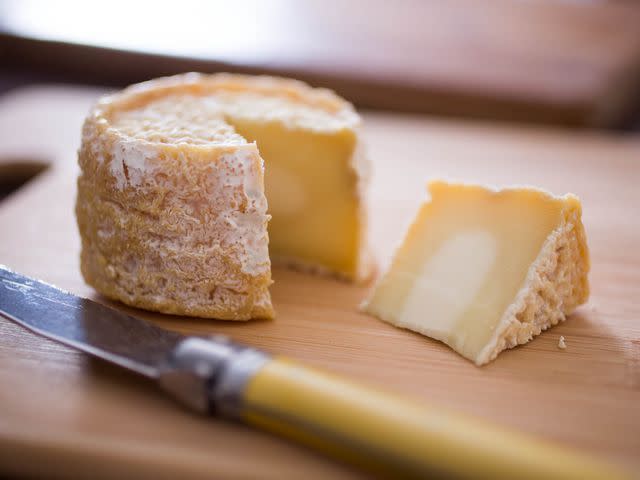
Serious Eats / Vicky Wasik
Where it's from: France.
Milk: Cow.
(Un)Pasteurized
Aroma: Hay and goat milk.
Flavor: Sweet and tart.
Texture: Cream leading to velvet.
Character: The goat upgrade.
Europe inspires me for its large-ish-scale "factory" producers that still prioritize tradition and hand-crafted technique. In this case, Sèvre & Belle Cooperative has the sixth-largest production of goat cheese in France, but still hand-ladles all its curd into teeny tiny molds, and works only with fresh goat milk (rather than frozen curd). Based with the department of Poitou-Charentes, in the town of Celles-sur-Belle, they make pasteurized cheeses for the American market, but from the same facility produce raw milk versions of the same cheeses. And the flavor and consistency is remarkably high.
Le Chevrot was a door-opening cheese for me, proving that a mold/yeast-ripened goat cheese could be an entirely different animal from a fresh, lactic, lemony chèvre. It's a beautiful little drum, the color of almond milk, and covered in a wrinkly, brain-like rind that is the calling card of the yeast geotrichum. Accordingly, its flavor is sweet and mellow, with nutty undertones, while the snow-white center of the cheese has a mouthwatering tang.
The combination becomes compulsive, so you keep going back for more, outer rind, inner paste, until the whole eight-ounce round vanishes. The greatest danger is that as the cheese dries out, its brainy ridges deflate and shrink, and it takes on a piquant, potentially soapy edge. But if that's the worst case scenario you're in pretty good shape.
February 2015
Read the original article on Serious Eats.

